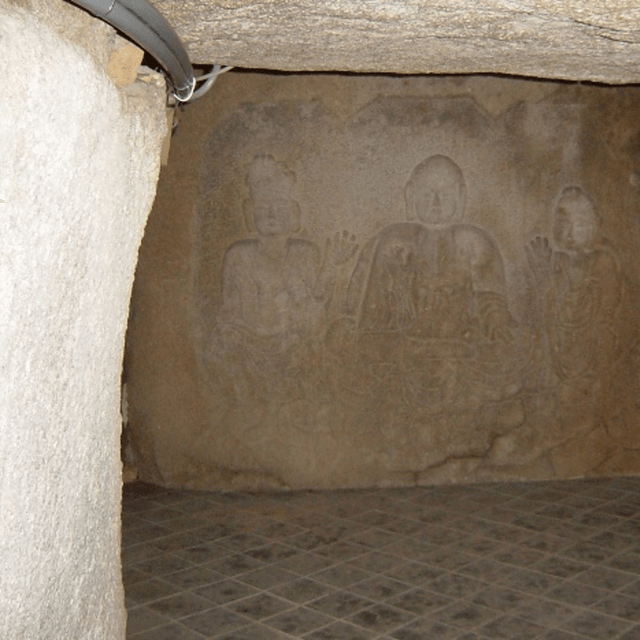
寺塚穴観音古墳は曹洞宗補陀山興宗寺(ほださんこうしゅうじ)の境内に所在する径約20mの円墳。玄室の奥壁中央に阿弥陀、左右に観音、勢至両菩薩が浮彫りされ、両袖石にも仁王の彫刻がなされています。作者・制作時期はいずれも不明ですが、穴観音と呼ばれ、古くから信仰されてきました。
巨石を用いた石室は北部九州でも屈指の規模を誇るうえ、博多区の巨石墳である今里不動(いまさとふどう)古墳とも時期的に近いことから、当時の福岡平野の西部(寺塚穴観音古墳)と東部(今里不動古墳)の政治動向を考えるうえで重要な古墳といえます。
周囲は貝原益軒(かいばらえきけん)著『筑前国続風土記(ちくぜんのくにぞくふどき)』などで「百塚」と呼ばれることから、かつては多くの古墳が存在していたと考えられますが、福岡城築城に際し、石垣石材として石室の石が抜かれる等、後世の改変が著しく、壊滅したと考えられます。
Located within the precincts of Hōdasan Kōshū-ji Temple, this is a circular burial tomb (kofun) about 20 meters in diameter. In the rear wall of the main chamber, a relief of Amida is carved in the center, with Kannon and Seishi Bodhisattvas to left and right; reliefs of the two Niō (guardian deities) are also carved on the flanking stones. The sculptor and date are unknown, but the site has long been venerated under the name “Ana Kannon” (“Cave Kannon”).
The stone chamber, built of massive monoliths, is among the largest of its kind in northern Kyushu. Because it is close in date to the Imazato Fudō Kofun—another megalithic tomb in Hakata Ward—the site is important for considering the political circumstances of the time across the Fukuoka Plain, west (Terazuka Anakannon Kofun) and east (Imazato Fudō Kofun).
The surrounding area is called “Hyakuzuka” (“One Hundred Mounds”) in works such as Kaibara Ekiken’s Chikuzen no Kuni Zokufudoki, a geographical record of the Chikuzen region, suggesting that many such kofun once existed here. However, during the construction of Fukuoka Castle, stones from the chambers were removed for use in the castle’s ramparts, and later alterations were so extensive that these mounds are thought to have been largely destroyed.
スタンプを獲得すると、限定の壁紙をゲットできます。
スタンプを集めてね / Collect a stamp
限定の壁紙を獲得しました。
以下のボタンから壁紙を表示し、長押しで”写真”に保存してください。
